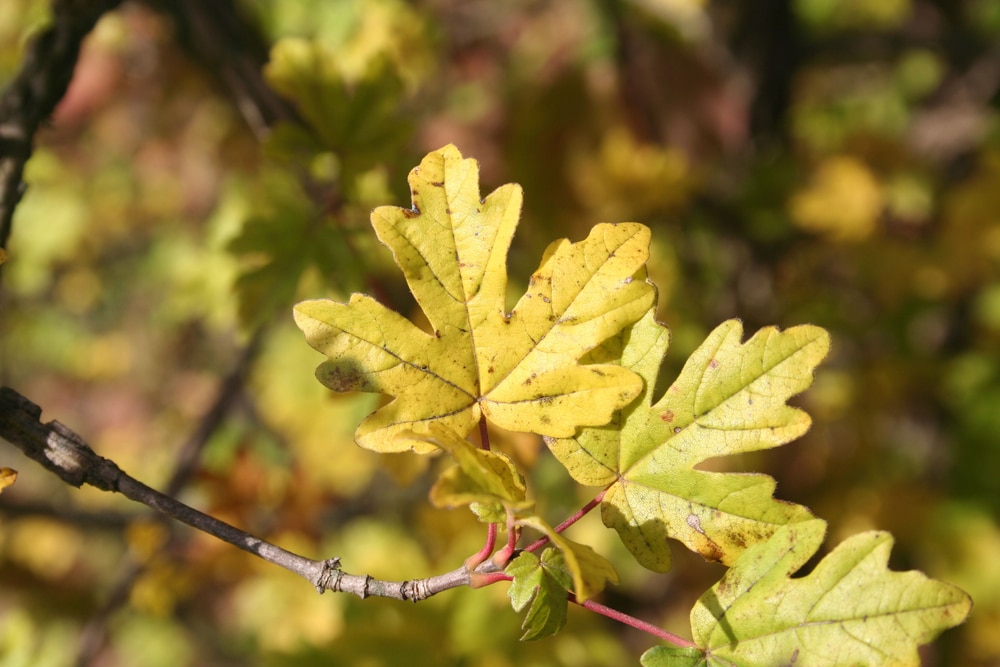Last Updated on
Acer campestre, commonly known as field maple, is part of the Sapindaceae family. It is a deciduous flowering tree that is often planted in gardens and parks as an ornamental tree or hedging plant. In Autumn, the foliage on field maple trees turns bright yellow to red in colour before falling off for the winter. They are hardy trees that can be found around the world thanks to how widely they have been planted and their beautiful display of Autumn colour.
Other common names, depending on the region, for acer campestre include hedge maple, dog oak, and common maple.
Overview
- Scientific Name: Acer Campestre
- Common Name/s: field maple, common maple, hedge maple, dog oak
- Family: Sapindaceae
- Origin: native
- Habitat: hedgerows, mixed woodland
Field Maple Identifying Features
What does a field maple tree look like? Whether you are contemplating planting a field maple in your garden or simply wish to be able to identify them in the wild, we think the best place to start is by learning about its recognisable features.
Leaves and Buds

The acer campestre has brown stems with dark brown egg-shaped buds in the winter. The buds grow in pairs.
The green field maple leaf grows in pairs opposite each other. They have broad, lobed leaves with five bluntly-shaped, rounded tips. The margin between the lobes is somewhat smoother. As we mentioned above, the leaves fall in the Autumn after they lose their green colour and are re-grown in the Spring.
Flowers
The flowers on a field maple bloom in the Spring, usually in May, in concurrence with the leaves opening. The flowers are yellowish-green in colour and grow in clusters pointing toward the sky. The fruits on a field maple grow in winged nutlets with two sides.
Bark
The bark on an acer campestre tree is grey-brown in colour with a somewhat corky feel. The bark on a young field maple is smooth at first, but a fine vertically fissured texture and appearance develop over time.
Wood
A field maple contains white wood that is both strong and hard. It is often used to make furniture, musical instruments, and flooring. However, it doesn’t have a consistent growth pattern, so it is not one of the most commonly used types of wood.
How Big Does a Field Maple Grow?
Typically, the field maple species grow to a size between 15 and 25 metres in height. The trunk can grow to be as large as 1 meter in diameter. The crown of a field maple usually sits at the height of about 3 metres, making it a welcome home for bird’s nests and other species of wildlife.
How Fast Does Field Maple Grow?
The field maple tree, or plant, grows rapidly during its initial life stages. However, it eventually slows down and grows much slower later in life. In fact, these plants are often overtaken by other more ambitious trees in a growing forest. Most field maples grow to be about 150 years old.
Where Does Field Maple Grow?
Field maple is native to Britain, large parts of continental Europe, North Africa, and Southwest Asia. Aside from its native regions, it has widely been introduced and planted in non-native areas in Australia, the USA, and areas in Europe outside its original native regions.
The field maple plant is shade tolerant when it is young but can be grown in full sun to partial shade. When the tree reaches its seed-bearing years, it requires much more light and can no longer grow well with significant shade.
The field maple prefers neutral to alkaline soil. It can occasionally be found in acidic soil, but this is rare and not considered ideal as far as growing conditions are concerned.
Is Field Maple Poisonous?
Acer campestre is not poisonous to wildlife. However, other maple species produce toxins that are considered poisonous. Either way, maple is not edible. In addition, some reports indicate that field maple can cause allergy-like respiratory symptoms, runny nose, and even skin irritation in humans.
Emily is a woman of many talents. She has a B.A. in English and enjoys writing. Emily loves accessorising her home with quality products that not only serve a purpose but also enhance the overall convenience and tranquillity of her living space; there’s nothing like coming home to your own personal sanctuary after a long day! She loves anything that can make life easier or more comfortable—from dishware to furniture to lighting fixtures.



